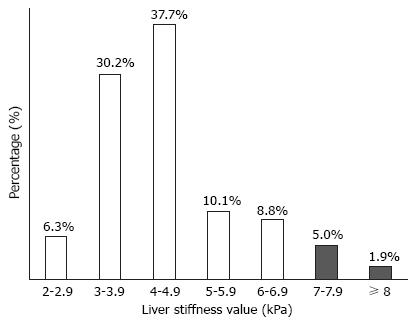Copyright
©The Author(s) 2015.
World J Gastroenterol. Jan 28, 2015; 21(4): 1158-1166
Published online Jan 28, 2015. doi: 10.3748/wjg.v21.i4.1158
Published online Jan 28, 2015. doi: 10.3748/wjg.v21.i4.1158
Figure 1 Recruitment algorithm.
A total of 190 consecutive subjects who received full medical health check-ups were recruited. Five patients were excluded due to inappropriate liver stiffness measurements. Of 185 subjects with valid liver stiffness values, 26 were excluded based on exclusion criteria. A total of 159 subjects were selected for final statistical analysis.
Figure 2 Distribution of liver stiffness values.
Among study participants, significant liver fibrosis (> 7 kPa) was observed in 11 (6.9%).
Figure 3 Proportion of subjects with significant liver fibrosis (> 7 kPa) according to four independent predictors.
A: Body mass index; B: Alanine aminotransferase; C: Calcified carotid plaque; D: Number of calcified carotid plaques. The proportion of significant liver fibrosis was higher in subjects with high body mass index (≥ 24.2 kg/m2), high alanine aminotransferase (≥ 19 IU/L), and thicker IMT (≥ 0.68 mm) than in their counterparts (12.7% vs 1.3%, 11.5% vs 2.5%, 12.7 vs 1.3%, respectively; All P < 0.05). Subjects with higher numbers of calcified carotid plaques (≥ 1) were prone to have significant liver fibrosis with borderline statistical significance (14.3% vs 4.8%, P = 0.065).
- Citation: You SC, Kim KJ, Kim SU, Kim BK, Park JY, Kim DY, Ahn SH, Lee WJ, Han KH. Factors associated with significant liver fibrosis assessed using transient elastography in general population. World J Gastroenterol 2015; 21(4): 1158-1166
- URL: https://www.wjgnet.com/1007-9327/full/v21/i4/1158.htm
- DOI: https://dx.doi.org/10.3748/wjg.v21.i4.1158











